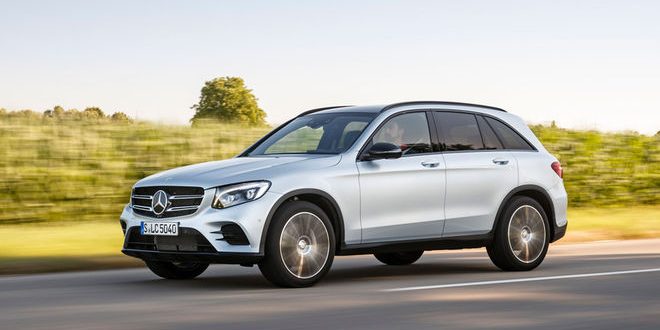The 2016 Mercedes-Benz GLC-Class will arrive later this year, as a new nameplate with a look that’s entirely different than that of its predecessor. And behind it, there seems to be an indelible backstory.
It has the looks, tech and driver appeal and will definitely go some way into stealing sales from BMW and Audi. The engine range is lacking variety but the four-cylinder diesels offer all the performance, economy and refinement you could ask for. In terms of practicality, it matches the X3 and Q5 punch for punch, while being the more handsome SUV of the three, too.
Mercedes GLC 220d Sport
The GLC is the first taste of Mercedes’ compact SUV we’ve had in the UK – its predecessor, the GLK, was never tooled up for right-hand drive. It’s intended to compete with the likes of the Audi Q5 and BMW X3 – though a sleeker BMW X4-rivalling GLC Coupe is on the way.
The standard five-door GLC SUV is expected to see a similar range of petrol and hybrid engines as the C-Class saloon, but for the time being the lineup is diesel-only. That means a choice of GLC 220d and GLC 250d, both of which use the 2.1-litre diesel engine from the Mercedes C-Class saloon. With 168bhp and 201bhp respectively, neither will set the pulse racing – but both offer impressive refinement and best-in-class fuel economy of up to 56.5mpg. A nine-speed automatic gearbox is standard across all UK models.
No AMG-GLC 63 has been confirmed yet, though there’s a GLC 43 AMG and a 350e plug-in hybrid. That car does 0-62mph in 5.9 seconds yet emits just 60g/km of CO2, meaning rock-bottom company car costs and free road tax. It also boasts an all-electric range of 21 miles.
Specs are extensive and a little confusing, with basic SE, Sport and AMG Line cars also available with SE Executive, Premium or Premium Plus packages. All cars get an automatic tailgate, reversing camera, privacy glass, DAB and keyless go. As with other Mercs, the Sport and AMG Line cars get bigger wheels, more aggressive styling and bespoke interior options, as well as park assist, sat-nav and heated front seats.
Engines
We wouldn’t bother with the more powerful GLC 250d, as the 220d is almost as fast and costs less. The latter will do 0-62mph in 8.3 seconds and hit 130mph flat out, while the 250d cuts this to 7.6 seconds and adds an extra 8mph to the top speed. Theoretically, the higher-powered car should be more fun to drive, thanks to its 31:69 front-rear torque split, but in all honesty you’ll struggle to tell the difference between this and the 45:55 separation on the GLC 220d.
Both use the 2.1-litre diesel from the C-Class, with 168bhp and 201bhp respectively, while the more powerful model also packs an extra 100Nm of torque. It is livelier when you floor the throttle, but the standard car should be enough for most people.
MPG, CO2 and running costs
Despite being a mid-sized SUV, Mercedes claims both diesel models will return more than 50mpg. In fact, no matter which you go for, both quote identical fuel economy and emissions numbers.
That means both cars will do 56.5mpg and emit just 129g/km of CO2. An Audi Q5 2.0-litre TDI Quattro will return 50.4mpg and 147g/km while a similarly-specced BMW X3 xDrive 20d does 52.3mpg and 142g/km – meaning the Merc should trounce them on day-to-day running costs.
There’s a plug-in hybrid 350e on the way, too, although it won’t arrive in the UK until late 2016. That car will do 109mpg, and emit just 60g/km of CO2 for free road tax. It’s a shame we won’t get it here for such a long time because the cheap bills and tax benefits would be a massive plus for company car drivers.
Servicing and maintenance costs should be on a par with the BMW and Audi, and the fact it shares a number of parts with the C-Class saloon should bring down costs in the long term.
Mercedes pulled out all the stops to ensure victory over its German rivals in the 2015 Driver Power owner satisfaction survey.
An 11th place finish saw it top BMW, Audi and Volkswagen – with owners praising their Mercs for ease of driving, performance and build quality. Practicality and running costs were two of the worst categories for Mercedes, though the spacious and frugal GLC should provide better results in 2016.
Because the GLC is such a new car, it didn’t feature in the run-down of the top 200 models. The C-Class came an impressive 42nd – though there were questions remain over the car’s reliability, finishing 188th overall.
In terms of safety, the GLC should be one of the top cars in its class. While we’ll need to wait until Euro NCAP put the SUV through its stringent crash tests, we already expect it to surpass the BMW X3 and Audi Q5 thanks to its plethora of safety systems.
All GLCs get ESP with Dynamic Cornering Assist, Crosswind Assist and Collision Prevention Assist Plus. Of course, like many new cars there’s a host of airbags, seatbelt reminders and ABS brakes, while buyers can also spec Distronic Plus with Steering Assist and Stop&Go Pilot. This allows drivers a degree of autonomy – with the car able to accelerate, steer and brake of its own accord in busy motorway traffic.
Agencies/Canadajournal
 Canada Journal – News of the World Articles and videos to bring you the biggest Canadian news stories from across the country every day
Canada Journal – News of the World Articles and videos to bring you the biggest Canadian news stories from across the country every day



